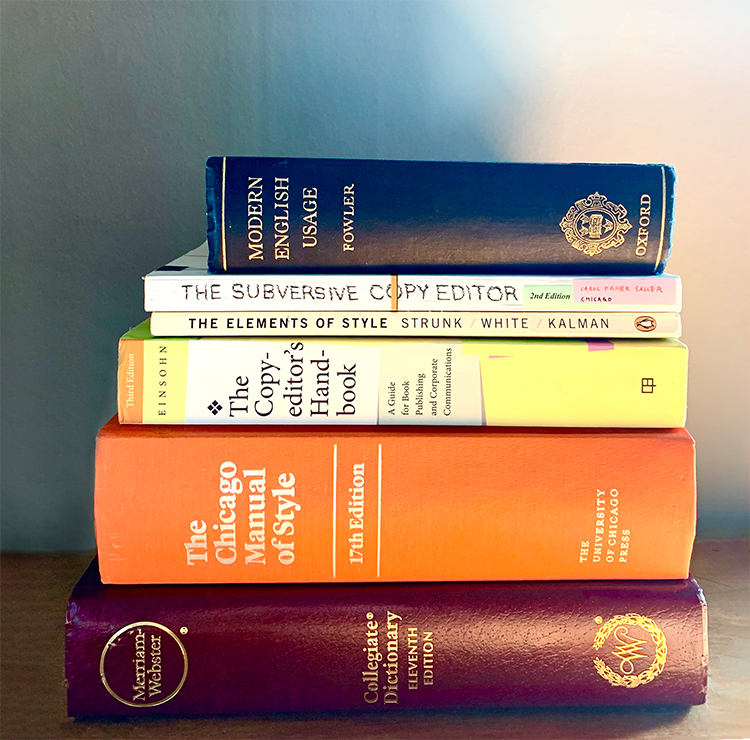Good editing is a balance between following usage and grammar conventions and applying them thoughtfully. A successful editor hones writing for clarity and cohesion while letting the author’s voice come through. Whether editing your own writing or someone else’s, the following tips can help you streamline and improve your work.
BECOME FAMILIAR WITH COMMON USAGE PITFALLS
Editors keep their resources handy. The Chicago Manual of Style, Merriam-Webster Dictionary, and Elements of Style by Strunk and White are some essential tools. It’s not necessary (or possible) to memorize everything—but familiarity with common usage errors will help flag them when you edit. Here are a few common examples of usage confusion:
Was vs. were
This is determined by the linguistic “mood.” Merriam-Webster provides a succinct and easy-to-understand explanation of moods in language.
English has three moods. The indicative mood is for stating facts and opinions like “That cat is fabulous.” The imperative mood is for giving orders and instructions (usually with an understood subject, you), as in “Look at that fabulous cat.” The subjunctive mood is for expressing wishes, proposals, suggestions, or imagined situations, as in “I wish I could look at that fabulous cat all day.”
If you are writing about something that is not a fact, opinion, or instruction, it is likely in the subjunctive mood, requiring “were.”
If my dog were able to speak, he would request biscuits all day.
Instead of
If my dog was able to speak . . .
Further explanation can be found at merriamwebster.com.
Further vs. farther
The difference between these two words is figurative and literal distance.
Let’s discuss this issue further.
or
Let’s discuss whether we should walk the dog farther today that we did yesterday.
Grammar Girl offers some great tips on the topic.
Me vs. I
This tricky usage situation can be solved by considering the subject and object of a sentence. The subject is who or what is doing the action, and the object is who or what the action is being done to. Use “I” when referring to the subject and, in general, “me” when referring to the object.
My dog and I were invited to a party.
but
The party invitation was sent to my dog and me.
TED-Ed offers a quick and fun video tutorial on the topic.
DEMYSTIFY THE COMMA
Commas can be complicated and sometimes subjective. There are hard and fast rules, but ensuring clarity should be your priority. Spend some time getting to know the rules (or where to find them). Considering the structure of a sentence is key.
The Elements of Style contains an excellent overview of comma usage. The most common points of confusion are explained by the following suggestions:
“Place a comma before a conjunction introducing an independent clause” (Strunk and White 11).
It is raining, but a walk may still be pleasant.
”Do not join independent clauses with a comma” (Strunk and White 11). If the two statements are closely related, use a semicolon. If not, use a period.
I walked my dog four times today; he would have preferred five.
I walked my dog four times today. I can’t wait for this rain to end.
Grammarly provides a clear and thorough primer on comma usage.
DON’T SACRIFICE THE AUTHOR’S VOICE IN THE QUEST FOR PERFECT GRAMMAR
Before you begin editing, read through the work to get a sense of the writer’s style. Strunk and White explain style in the following statement:
Style is an increment in writing. When we speak of Fitzgerald’s style, we don’t mean his command of the relative pronoun, we mean the sound his words make on paper. All writers, by the way they use the language, reveal something of their spirits, their habits, their capacities, and their biases. This is inevitable as well as enjoyable. All writing is communication; creative writing is communication through revelation—it is the Self escaping into the open. No writer long remains incognito (Strunk and White 98).
Next time you read, particularly fiction, consider what it is that makes the language in a manuscript unique so that you learn to preserve it when editing. Keeping the author’s voice requires thoughtful judgment and may require letting some grammar rules or preferences go. Try to get a sense of their particular cadence or patterns, and be careful not to eliminate their style by overediting.


Meredith Wadley
Great advice! May I suggest adding Dreyer’s English, AN UTTERLY CORRECT GUIDE TO CLARITY AND STYLE by Benjamin Dreyer to the stack? https://www.penguinrandomhouse.com/books/232363/dreyers-english-by-benjamin-dreyer/
Meredith Wadley
Great advice! May I suggest adding Dreyer’s English, AN UTTERLY CORRECT GUIDE TO CLARITY AND STYLE by Benjamin Dreyer to the stack? https://www.penguinrandomhouse.com/books/232363/dreyers-english-by-benjamin-dreyer/